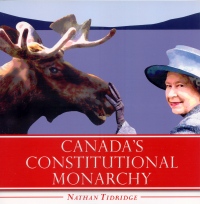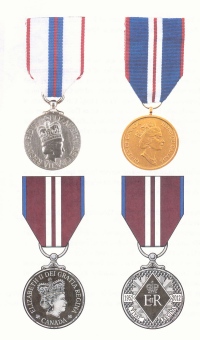| ________________
CM . . . . Volume XVIII Number 22 . . . . February 10, 2012
excerpt:
Nathan Tidridge is an acclaimed high school teacher of history and government in Ontario. This suggests that he has succeeded, where many other teachers of civics have struggled, in making the study of how Canadians govern themselves both interesting and meaningful to teenagers.
Tidridge starts with the Crown's role in the history of Canada, beginning with the earliest English and French exploration and settlement in what would eventually become British North America. He emphasizes significant events through the centuries, including the King-Byng crisis of 1926 and ending with the prorogation of Parliament in 2008 when Canadians were awakened to the constitutional role played by the governors general and the Sovereign or monarch they represent. In a chapter that addresses the Canadian constitution and authority at both the federal and provincial levels, Tidridge explains that the constitution in Canada is composed of both written and unwritten components, unlike our American neighbours who have a single written document. One of the strongest arguments in support of his thesis on the importance of the Crown is the reserve power of the Crown: The Royal Prerogative whereby the Sovereign or her representative can refuse to follow a prime minister/premier and the respective Cabinet's advice in extreme cases, such as a minister's abuse of power and violation of the constitution. Some of the concepts explored are abstract and may be challenging for readers. Tidridge addresses this potential problem in his discussion of the Queen personifying the state when he effectively develops an analogy comparing the relationship between government and the Crown to a car that is in the name of the Queen with the driver being the prime minister who is helped along by the passengers (The Cabinet and all Members of Parliament), and with a Senate checking the directions and planned path of the journey. There is a fair amount of repetition as separate chapters discuss the functions of the Queen, the governor general and the national Crown, the lieutenant governors and the provincial Crowns. Additional chapters address the broad topics of the Crown in day-to-day life (for example the Royal prefix in names of and Royal patronage of organizations), First Nations and the Crown, the military and the Crown, the Canadian honours system, the Canadian heraldic authority, Royal and vice-regal tours (that function to "highlight significant milestones and/or achievements in the life of the country"), the heir to the throne, and the Commonwealth and the Queen's other realms. Tidridge employs a choppy writing style. All chapters are broken into short segments with descriptive subheadings. Especially in the first third of the volume, as demonstrated in the excerpt above, he incorporates short quotations from other scholars and former officials. He provides samples of oaths (those sworn/declared by members of the Privy Council, the Canadian Oath of Citizenship) showing the relation of an individual to the Crown. He makes extensive use of bulleted lists. All is supplemented by copious illustrations, mostly in colour, including a couple of maps. The fragmentary nature of the writing, abundant use of lists, and the numerous appendices that are, themselves, often comprised of lists makes this work something of a hybrid between being a reference work and a monograph intended to be read from cover to cover. A useful index and an extensive bibliography are included. One appendix contains websites and another definitions. Much of the textual and illustrative contents of the book emphasizes the importance of ceremony, symbolism, the complex system of honours, and heraldic developments in Canada. There is a danger that readers will view the emphasis on arcane rules of ceremonies, heraldry and the ongoing development of new Canadian honours by many governors general as so much style and symbolism over substance. Despite some reservations, this volume deserves wide availability in secondary schools and public libraries across Canada. The volume will be of particular value to teachers of Canadian civics, trivia buffs (see especially Appendix A: Did you know?) and, of course, monarchists of all ages. It is unlikely that the average student will rush to sign out the book, despite the fetching cover image of Charles Pachter's painting Love Pat that depicts Queen Elizabeth II and a moose. Readers may want to consult many of the publisher's related juvenile and adult works for more detailed information on Royal Tours, Canadian Symbols of Authority, and Canadian Honours. See for example Christopher McCreery's The Beginners Guide to Canadian Honours (CM, Vol. XV, No. 4, October 10, 2008). Recommended. Val Ken Lem is the liaison librarian for History, English and Caribbean studies at Ryerson University.
To comment
on this title or this review, send mail to cm@umanitoba.ca.
Copyright © the Manitoba Library Association. Reproduction for personal
use is permitted only if this copyright notice is maintained. Any
other reproduction is prohibited without permission.
NEXT REVIEW |
TABLE OF CONTENTS FOR THIS ISSUE
- February 10, 2012.
AUTHORS |
TITLES |
MEDIA REVIEWS |
PROFILES |
BACK ISSUES |
SEARCH |
CMARCHIVE |
HOME |

 In this work, Tidridge emphasizes the importance of the Crown in our form of constitutional government. In doing so, he seeks to address the shortcomings of most provincial education curricula that downplay the position of the Canadian Crown in government to being a mere "symbolic institution with no impact on the day-to-day lives of Canadians." It is debatable whether this work will convince the reader as to the importance of the Crown in Canada, but it will succeed in educating the reader about the evolution of our government.
In this work, Tidridge emphasizes the importance of the Crown in our form of constitutional government. In doing so, he seeks to address the shortcomings of most provincial education curricula that downplay the position of the Canadian Crown in government to being a mere "symbolic institution with no impact on the day-to-day lives of Canadians." It is debatable whether this work will convince the reader as to the importance of the Crown in Canada, but it will succeed in educating the reader about the evolution of our government.